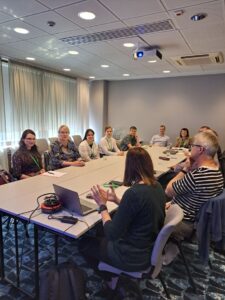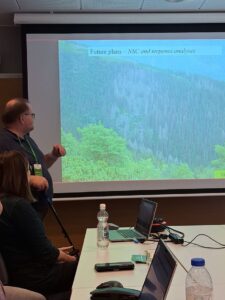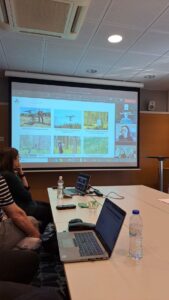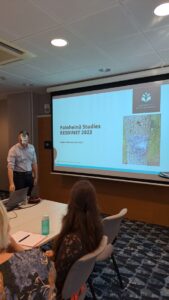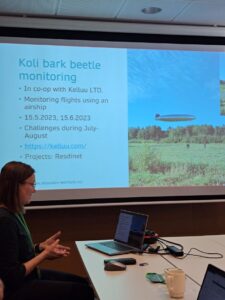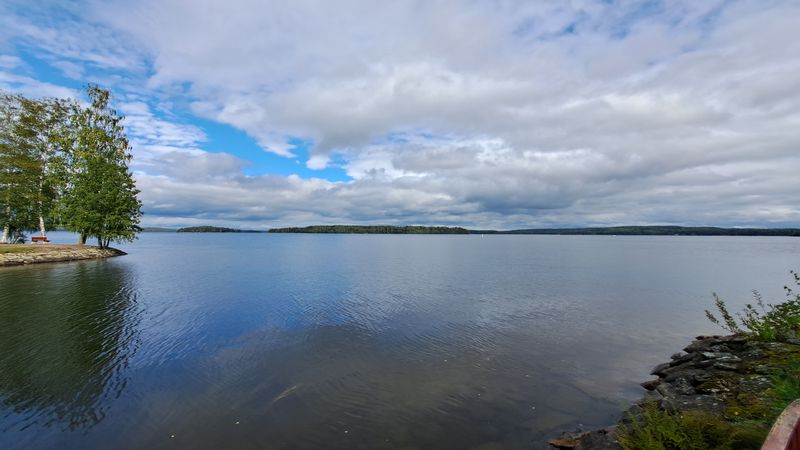On the 29th of August 2023, the team members of two European projects, RESDiNET and MULTIRISK, got together at a joint meeting to discuss the prospects of possible future cooperation and share the results and progress in the use of remote sensing methods to study the “bark beetle – Norway spruce” interactions in the changing climate.
The event took place in the Hotel Scandic Park Helsinki (Mannerheimintie 46, 00260 Helsinki) from 15:00 to 17:00 (EEST). The meeting was organized as a side event during the IBFRA 2023 conference. The meeting was attended by 16 people in total, including 14 on-site and two online participants representing the University of Eastern Finland (UEF), Finnish Geospatial Research Institute (FGI) of the National Land Survey of Finland (NLS), the Institute of Forest Ecology of the Slovak Academy of Sciences (IFE SAS), the Swedish University of Agricultural Sciences (SLU), and the University of Helsinki. During the meeting, five in-person and online scientific presentations were followed by a discussion of the cooperation prospects and plans for years 2024-2025 and the upcoming annual RESDiNET meeting in Koli in 2024.
The meeting was opened by prof. Eija Honkavaara (FGI NLS, Finland) who welcomed the participants and introduced them to each other. Dr. Rastislav Jakuš (IFE SAS, Slovakia) delivered the first presentation on field work conducted in Slovakia and Italy in 2023. He showcased his spring experiments in Bujakovo (Slovakia) aimed to study the differences in the hyperspectral signatures of infested (susceptible) vs. non-attacked (resistant) mature trees growing in the provenance plots dominated by Norway spruce. To acquire remotely sensed data for this study, the SwissDrone Dragon 50 equipped with a hyperspectral sensor of 400-1000 nm spectral range was used. Dr. Jakuš shared his experience gained during a five-year roofing experiment in the School Forestry Enterprise in Kostelec nad Černými lesy (Czechia) within the EXTEMIT-K project. One of the important findings was the so-called “vaccination effect”, i.e. induced tree resistance to beetles that presumably ensued multiple sampling of these trees during several years preceding the experiment. In Sutrio province in the Italian Alps, Dr. Jakuš conducted another field experiment in the natural spruce-dominated mountain stands currently disturbed by bark beetle Ips typographus outbreaks. The experimental design involved the use of anti-attractants and pheromones to investigate bark beetle infestation patterns and tree susceptibility to bark beetles. He highlighted the importance of using airborne imagery in montane conditions where the steep slopes prevent accurate measurements of the distance between a given tree and the nearest previously infested stands using the laser scanning tools.
Dr. Langning Huo (SLU, Sweden) presented the progress in the field campaign at Remningstorp aimed at monitoring of bark beetle damages in spruce stands. In 2021, in southern Sweden, the SLU researchers conducted a controlled field experiment in a 1200 ha productive managed forest disturbed by bark beetle I. typographus outbreaks. The experimental design involved the monitoring of six stands, with four study plots in each, using field surveys and remote sensing campaigns, namely the flights of a drone equipped with a hyperspectral sensor. Sap flow stations were installed in each plot to measure tree physiological parameters. During the regular field surveys, holes, dust and needle discoloration were used as criteria for bark beetle infestation and tree status checks. In 2021, out of 977 monitored spruce trees, 208 were beetle-attacked and died, while in 2023, out of 1017 monitored trees, 155 were preliminarily classified as beetle-attacked and dead. Dr. Huo pointed out that despite the number of colonized trees increasing over time in the long run, in 2023 the infestation frequency somewhat decreased compared to the previous peaking years. Dr. Langning Huo also touched upon the plans for field work in 2024, including the monitoring of existing plots in Remningstorp using the sap flow stations and drone flights. According to Dr. Huo, another study area was supposed to be in Umeå where the researchers expected to use a ring-barking technique to simulate bark beetle attacks in stands experiencing relatively low bark beetle population densities. The aim of this experiment is to investigate tree susceptibility to pest insect using tree hyperspectral signatures and sapflow measurements. Dr. Rastislav Jakuš suggested that ring barking of trees may not be enough to stress the trees to an extent when they will become attractive hosts for I. typographus. According to him, inoculation of Methyl jasmonate, a volatile organic compound that mimics bark beetle infestations, possibly coupled with pheromones mounted on the trees, might prove a more effective solution under low natural bark beetle pressure. During the ensuing discussion, prof. Eija Honkavaara and prof. Päivi Lyytikäinen-Saarenmaa emphasized the lack of the European or international level standards for measuring bark beetle population, which complicated the comparisons among different countries and study areas.
Mikko Pelto-Arvo, a PhD student from the Department of Forest Sciences, University of Helsinki, presented his field work experiments in Paloheinä (Finland), a conservation area that was severely affected by drought in 2021-2022. The study is supervised by prof. Päivi Lyytikäinen-Saarenmaa (UEF, Finland). The fieldwork setup and equipment involve 52 dendrometers installed at three sites, with 15 trees in each site being measured for sap flow. To monitor bark beetle population densities, 2×3 pheromone traps are used, and tree statuses are recorded weekly using visual inspections. The soil moisture and texture parameters are measured using the laser diffraction method. Mikko shared his insights into the trap catch dynamics, which peaked in June 2023, declined by the 1st of July, and then increased again by the period between the 24th – 31st of July, 2023. In August 2023, bark beetle population density decreased. Mikko emphasised that two pronounced peaks observed in the bark beetle population dynamics corresponded to two generations of I. typographus that emerged in the study area in 2023.
Prof. Eija Honkavaara presented about Kelluu airship flights conducted in a 130 ha research area in Koli (Finland) in May-June 2023. The hydrogen-fueled unmanned airship manufactured by Kelluu, Ltd. (Joensuu, Finland) can stay in the air up to 12 hours non-stop gathering remotely sensed information. The flights of the airship aimed to acquire hyperspectral images of 28 circular sampling plots, 10 m radius each. Prof. Honkavaara also described the monitoring of the Paloheinä research area using remote sensing tools. The field campaign resulted from the mutual efforts of RESDiNET and MULTIRISK project team members. The helicopter was equipped with multispectral (MS) and hyperspectral (HS) sensors that captured images at wavelengths starting from 133 nm. The acquired data comprised as much as 2 billion points for each dataset. In addition to the use of the multispectral and hyperspectral sensors, the targeted area was also scanned with a LiDAR sensor. According to prof. Honkavaara, the LiDAR data allows to overcome the disadvantages of using the hyperspectral data alone. The deep leaning methods will be used to analyse the acquired RGB/MS/HS imagery. In the Paloheinä area, the dead beetle-killed trees will be detected using YOLO (You Only Look Once), a neural network-based method of object detection that makes predictions of bounding boxes and class probabilities all at once. Prof. Honkavaara emphasised that the collected data has a big potential to improve the existing forest health diagnostic methods. Particularly, the scanning density of 500 points /m2 enables identification of tree branches with a 5 cm resolution, making it a potentially powerful tool for forest monitoring and decision making. In the last part of the presentation, prof. Honkavaara mentioned the regular multiyear drone flights to acquire the time series imagery from the study areas in Finland currently disturbed by bark beetle outbreaks.
In the concluding discussion, the participants shared their thoughts and ideas on the cooperation plans for the years 2024-2025 and the upcoming annual meeting that will take place in Koli NP in 2024.
The RESDiNET team members are very thankful to prof. Honkavaara and prof. Päivi Lyytikäinen-Saarenmaa for excellent organisation of the joint meeting in Helsinki.
The MULTIRISK project aims to provide advanced digital technologies and risk management solutions and tools for mitigating forest disturbances caused by spruce bark beetles and storms. The project goal is to develop advanced geospatial technologies for detecting and monitoring forest disturbances and provide efficient solutions and tools for sustainable risk management at different spatial and temporal scales to support decision makers in forestry sector in the efforts to adapt to climate change and mitigate its consequences. The project is managed by the Department of Remote Sensing and Photogrammetry of FGI NLS.
